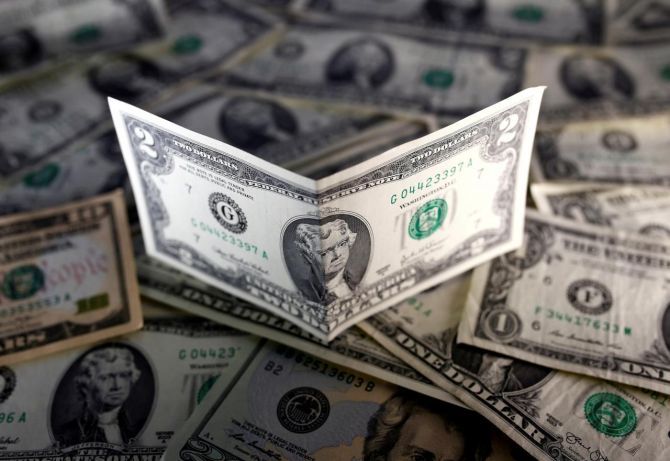 | « Back to article | Print this article |
India’s sovereign debt is much lower than that of other emerging economies like Argentina, Indonesia, Mexico, the Philippines, and South Africa.

India’s stock of external debt declined for the first-time since 2001-02, to $471.9 billion at the end of March 2017, according to the Reserve Bank of India’s December 2017 Bulletin.
The country’s external debt (medium to long-term) declined to 20.2 per cent of gross domestic product (GDP) at the end of March 2017, from 23.5 per cent at the end of March 2016. In March 1991, external debt was 28.7 per cent of GDP.
The main reason for contraction in non-resident deposits, says the report, was the “lumpy redemption” of FCNR(B) - Foreign Currency Non-Repatriable (bank) - deposits raised by lenders under a special swap-window scheme introduced during September to November 2013.
The report states the US dollar depreciation in relation to the Indian rupee over the past few cycles caused a valuation loss of $1.5 billion, which restricted the decline in external debt to $13.1 billion.
The share of rupee-denominated debt rose to 33.6 per cent at the end of March 2018, from 11.6 per cent in end March 2000.
Despite the stock of commercial borrowings declining to 36.7 per cent of external debt, it continues to represent the largest component, followed by NRI (non-resident Indian) deposits (24.8 per cent) and short-term trade credit (18.3 per cent).
Since 1991, successive governments have gradually opened up the country’s capital markets, expanding the stock of external debt from $83.8 billion in 1991 to $471.9 billion at end-March 2017.
Despite a massive increase in the quantum of external debt, the debt-to-GDP ratio has remained stable, declining from 37.3 per cent in 1992 to around 16.8 per cent by end March 2006.
At the end of March 2017, the country’s debt-to-GDP ratio rose to 20.2 per cent as throughout the early 2000s, the pace of expansion of the domestic economy in nominal terms was outpaced by the expansion of external debt demand.
This means that the pace at which domestics institutions were borrowing from abroad was greater than the rate of domestic growth.
The share of government debt (external borrowings by public sector/sovereign debt) declined to 20 per cent at the end of March 2017 from 48 per cent in 2000, while the private sector’s share (excluding the financial sector) has increased to 23 per cent at the end of March 2017 from 13 per cent in 1998.
The financial sector increased its share of external debt from 22 per cent in March 1998 to 32 per cent by end-March 2017.
The majority of external debt, Indians pursue, continues to be in the form of loans, followed by currency and deposits.
India’s sovereign debt is much lower than that of other emerging economies like Argentina (59 per cent), Indonesia (49 per cent), Mexico (45 per cent), the Philippines (41 per cent), and South Africa (39 per cent).
Photograph: Dado Ruvic/Reuters